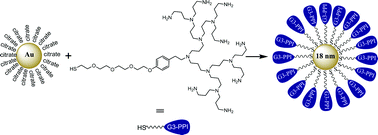Two poly(propyleneimine) dendrons (PPI dendrons) of third generation, containing eight branches (nitriles or primary amines) and having tyramine as the focal point, were prepared. A tetraethylene glycol spacer (TEG), terminated by a protected thiol group, was attached to their focal points. The obtained TEG–PPI dendrons were successfully used to cap 18 nm spherical gold nanoparticles, with no need for intermediate thioctic acid exchange of citrate, as previously reported for non-anionic ligands. The novel gold nanoparticle-cored PPI dendrimers were characterized by UV-visible and FT-IR spectroscopic techniques, dynamic light scattering (DLS), zeta-potential and transmission electron microscopy (TEM). Importantly, the amine terminated gold nanoparticle-cored PPI dendrimer showed great stability in PBS buffer, as well as in the presence of a salt, and they did not show any sign of degradation after freeze-drying. Also, this new type of PPI dendrimer was found to protonate at pH around 4.5 for their internal tertiary amines. The latter being present in large numbers on each gold nanoparticle, their protonation at pH below 5 will produce a proton-sponge effect, which plays a crucial role in lysosomal escape during drug delivery.

You have access to this article
 Please wait while we load your content...
Something went wrong. Try again?
Please wait while we load your content...
Something went wrong. Try again?


 Please wait while we load your content...
Please wait while we load your content...